#art conservation
Explore tagged Tumblr posts
Text
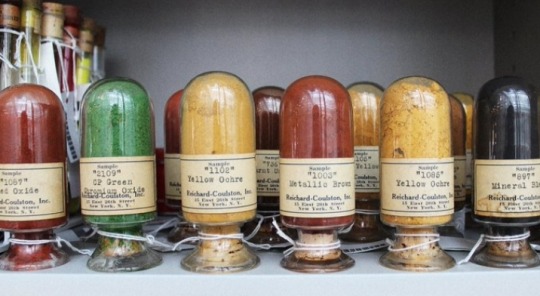
Harvard University has a library that protects the rarest colors in the world.
The Straus Center for Conservation and Technical Studies houses the Forbes Pigment Collection, which contains more than 2,500 samples of pigments, some incredibly rare and harvested from things like mummies, heavy metals, poisons, and precious minerals.
The collection was amassed by Edward Waldo Forbes (1873-1969), who directed Harvard's Fogg Museum, between 1910 and 1944.
Forbes is considered the Father of Art Conservation in the United States and spent most of his life traveling the world to collect various pigments that he used to authenticate classical Italian paintings.
The pigments are still used by art experts to authenticate and understand paintings.
#Harvard University#Straus Center for Conservation and Technical Studies#Forbes Pigment Collection#colors#pigments#Edward Forbes#Fogg Museum#Father of Art Conservation#art conservation#art#art experts#paintings#library
136 notes
·
View notes
Text

I'm a paper conservator (though I don't post about that often here, so don't follow me expecting this kind of content) and I'll be assisting with a chemistry course on blue pigments and dyes next semester. I'm also trying to help get the chemistry folks the funding to get an infrared camera to examine artwork in my art museum for potential pigment analysis.
If you like looking at illuminated manuscripts, the Fitzwilliam Museum at Cambridge has a gorgeous website called Illuminated: Manuscripts in the Making. It's full of high res images, often with infrared layers that you can examine too, and occasional microscopic images, and TONS of information about each manuscript including history, artistic style, artist's materials, etc. This website is the modern version of an old book of hours, beautiful and the highest quality and no expense spared.


This page (folio 20r) from The Hours of Isabella Stuart is fun for infrared examination. Most of the gorgeous blue was painted in ultramarine, which was one of the most expensive pigments, up there with gold, and it's the reason the Virgin Mary and Jesus are often portrayed wearing blue. But the owner, the duke of Brittany, changed the lady patron at the lower left (who may have been his first wife) and got an artist to paint his new fiancee Isabella Stuart instead, with her patron Saint Catherine behind her, clothed in ultramarine blue. Later he had it repainted again to change her headdress to a duchess's crown, but this time the artist used azurite blue which is slightly cheaper. It almost looks the same in normal light, but under infrared the azurite shows up as dark while ultramarine looks much lighter.
17 notes
·
View notes
Text

A painting i did two years ago for an art contest. It represents a serbian saint who was once a prince, but he left his life in order to become a monk. He sacrificed lavish beauty for the humble life of God. He went to Greece where he built many monasteries, and specifically a monastery Hilandar on Athos. He was a respected political, religious and humanaterian figure and was an important advisor to his brothers when they came on the throne.
In the painting there are many symbolisms, many of which are noticable.
Lamb represents Jesus, and in this picture, lamb is walking towards him as if he accepts him.
The white dove is holy spirit, it is observing him, almost hidden in the sky, yet is still present.
And then the eye shaped opening in the sky represnts God father, watching over him and elluminating the path. All three figures are making a triangle, meaning Holy Trinity...
Above him are three owls representing three wise men, since this is his rebirth, his new life and new world. Little bit behind him are lillies, symbolizing his royal blood. In front of him is a sword which he threw, he is rejecting the life of war, pain and violance. Next to him, on the tree is grape vine, grape vine is a symbol of his dynasty, it shows that at this point, his dynasty still looms over him.
There are some other minor details here and there, but these are the major symbolisms. Thank you!! ❤️✨
#traditional art#my art#artwork#art#artists on tumblr#painting#tumblr draw#my draws#drawing#slavic#history#christianity#religion#religious art#orthodox#christian art#original art#art conservation#symbolist art#flower symbolism#animal symbolism#god#medieval#etc
12 notes
·
View notes
Text
#tiktok#conservation#art conservation#art history#art#the metropolitan museum of art#edgar degas#metropolitan museum of art
47 notes
·
View notes
Text

It’s me ! but Star Trek addition (・`ω´・)
I definitely think I would be a science officer working in preservation of alien cultural objects ! Star Trek, in my opinion, is space anthropology, especially since their rules and values in field work mimic those of actual ethnographers. I’d like to think any objects of cultural heritage they receive are cared for and preserved by a team of space conservators :D
40 notes
·
View notes
Text




library in a hallwayyy
#asp#art student#dark academia#chaotic academia#university#dark academia university#polish artist#art conservation#library#dark academia library
8 notes
·
View notes
Text
Honestly, I wish to post more art conservation stuff on here. I'll never run an exclusively conservation themed blog I think, because I love silliness and fandom fun too much, but if my dearest mutuals and any other people following this account would be interested in it let me know!
#art#art history#art conservation#archaeology#archaeological conservation#archaeological finds#archaeologist#art conservator#modern art#modern art conservation#architecture#architecture conservation#personal#artists on tumblr#local seraph speaks
14 notes
·
View notes
Text

My favourite thing about my field is that I can claim reading this paper as "work research".
You can read it too! It's FREE access.
Also, can we just gave a "wahoo" for Donna Yates' approachable language? This is how you communicate science!
[Image ID:
A screenshot of a scientific paper published online by Cambridge University Press. It is entitled "T Rex is fierce, T rex is charismatic, T rex is litigious. Disruptive Objects in affective desirescapes. The authors are Donna Yates and Emily Peacock and it was published May 09 2024.
The abstract reads as follows:
In this paper we present T. rex fossils as disruptive objects that can drastically influence the actions and reactions of humans that encounter them. We present a vision of the T. rex as being a key node within a web of human and object associations that ultimately produces, first, extreme desire in humans, and then a breakdown in human relationships resulting in disagreements, disputes, lawsuits, and the committing of crime. From there we bring these T. rex fossils into the concept of desirescape which sees a network of object/object and object/human reactions provoking irresistible desire in humans. We argue that this desire can push humans to violate law or social norms or, in several T. rex cases, sue each other. How then should we humans approach T. rex and other disruptive objects? Cautiously, and with the knowledge that these objects may be more powerful than we are.
end ID]
#art conservation#art crime#donna yates#reference#t rex#tyranosaurus rex#dinosaurs#paleontology#criminology
10 notes
·
View notes
Text
Preserving the Past: The Importance of Restoration and Heritage Conservation in Museums
4 notes
·
View notes
Text
Here's a copy of a painting by JC Leyendecker that I made as an egg tempera wall painting.
I did have some issues painting this one of them being the fact that this is originally a newspaper cover illustration, and I decided to turn it into a 100x140 cm version (great choice). Overall, I'm relatively satisfied with how it turned out. My main issue is the skin complexion, which turned out a bit too yellow (trouble with the pigments I was using). The side sculptures also look a bit busted. Those were painted using lime technique (I think that's what it's called in English??) and that turned out to be pretty hard to manage.



#art history#traditional art#artwork#art#wall painting#wall art#art techniques#art technology#jc leyendecker#art restoration#art conservation
6 notes
·
View notes
Text
Work (an art museum): You’ve been here for 9 years as a part time contractor but the state won’t allow that any more, so now you’re a temp! Still no benefits only now with more hours and lower pay.
Me: $&@#!?
Work: Also you can only work for 11 months and then you have to be gone for 30 days before we hire you back. Last year you started as a temp on June 25, so your last day here is June 24.
Me: ugh ok
Work: You can come back after July 25.
Me: Well at least I’ll have the whole month of August to finish treating those five prints for the September exhibition. I have a little vacation planned so I’ll be back Wednesday July 31.
Me: (six weeks before leaving) Everyone, let me know if you need me to finish anything before I go, ok? Here are my dates. Otherwise I’ll finish stuff when I get back.
Work (three days before I leave) Oh by the way the photographer will be here the last week of July to photograph all the artwork for the September show.
Me: WHAT? They’re in the middle of treatment they’re not ready to be photographed! They’re still stained and wrinkly
Work: Also we can’t even start the rehiring process until about week 4 after you leave LOL so who knows how long the paperwork and background check will take, and you can’t start working again till it’s done.
Me: Ok, welp, enjoy your stained wrinkly artwork I guess.
12 notes
·
View notes
Text
Introduction
Historic House Museums
What is a historic house museum?
Historic house museums, or HHMs, are historic structures whose primary function has been to house people that now falls under the umbrella of "museum." People have many different definitions of "museum," "house," and "historic," however, and depending on who is asked, answers vary to the question "is [insert property] an HHM?"
This study follows the United States and the United Kingdom, for the US's museum culture stems from the UK (and wider European) museum structure. What could either group learn from the other? How can we continue to care for these buildings while serving the communities they are a part of? How do you ratify a structure's potentially painful history with the present? These are all questions we asked for this project as well as throughout learning about the ethics of museums and its application(s) to HHMs.
A Brief History of HHMs
For the purposes of this project, HHMs begin in the United States in 1853 with the creation of the Mount Vernon Ladies' Association. These women sought to save George Washington's Mount Vernon plantation in Virginia, and thus purchased the property with the intention of turning it into a museum to glorify Washington, an American hero, and reinforce American patriotism - a trendy stance in the 19th century. In the UK, the National Trust's establishment in 1895 marks their beginning of protecting historic structures. It is also important to note that in the United Kingdom, the National Trust's establishment was heavily intertwined with anti-industrialization sentiment, while in the United States preservation often comes with more explicit political strings attached (though to be clear, nothing is apolitical when it comes to museums).
The MVLA and the National Trust differed in goal and philosophy. The National Trust now owns more than 500 properties, many of which are HHMs; the UK has thousands of years of built history with evidence on every street corner, so the necessity for preservation of these structures is much more prevalent. The US, on the other hand, tends toward a breakneck sprint towards progress, often not looking back; historic structures often become asphalt for highways in the United States and can only be saved through laborious personal effort (see Jane Jacobs' unrelenting efforts to thwart Robert Moses' planned destruction of Greenwich Village, NYC in the 1950s). All this said, the US and UK's histories of HHMs start in different places.
Historically, the houses themselves were not considered pieces of art owned by a museum. The items held within the houses, however, were - the presumption was that "museum" infrastructure would serve an HHM just as well as it would a traditional art museum. Though this has changed in the past fifteen years and the structures themselves are now considered acquisitioned pieces of their respective museum organizers, approaches to HHMs require creative thinking and community building skills often not ascribed to the field of "museum professional." Still, scholarship on the ethics of museums and curation works tirelessly to correct these historic assumptions and make HHMs and other museum spaces places to build communities and learn about each other.
Art in (historic house) museums
"Art" can apply to many elements of an HHM - an architect might say that the house itself is the art while an art historian might explore the relationship between the house's owner, the art, and the house, noting the changes in styles of art and artists on display. A traditional western oil painter might appreciate the house and its well-appointed rooms but only pay close attention to the owner's impressive art collection. All of these theoretical perspectives are valid and, though merely narrow examples, all correct at once.
This project aims to disentangle art from the house. Of course, the nature of a historic home and a collection tied to its historic owner(s) means that that relationship cannot be fully disentangled. Still, not every HHM has a collection amassed by a single wealthy family over centuries of absolute power. We seek to understand the full applications of art/house relationships and explore its potential (and sometimes its tangibility) through two case studies of wildly different HHMs: Wiley House in the United States and Burghley House in the United Kingdom.
#art conservation#art restoration#historic architecture#historic preservation#house museums#museum#art history
2 notes
·
View notes
Text
87% of Classic Games (Any game released before 2010, including games like Super Mario Galaxy, Gears of War2, and Mirror's Edge) have been declared Missing.
Game companies have lobbied against conservation, saying that they do enough conservation by working publicly. This has since been disproven. Game companies do NOT do enough to conserve their games.
For many games, the only option is pirating. Game history experts say that if people didn't break or at least bend the law (whether as a consumer or while working on a game themselves) we wouldn't even have 13% of classic games (any game made before 2010).
For other games, the only option is finding it on a disk, though this is less likely. Many e-game store fronts (like the Xbox 360 store) will close, taking the only version we have of (some) those games with it. The Xbox 360 store will be shutting down July 2024.
The Wii U & Nintendo 3DS stores have recently closed. Ubisoft is determined to keep their costumers on subscriptions and when the games stop being worked on, they will shut down entirely. This includes both multiplayer AND singleplayer games.
You can help game conservation by going to StopKillingGames .com
#politics#us politics#world politics#lgbt#lgbtqia#lgbtq#lgbtq+#queer#art conservation#game conservation#video game conservation
7 notes
·
View notes
Text
would anyone be interested if i put together a masterpost of all the freeware/web rings/digital art/game conservation I know of? I have a large list and I think it might be time I start Sharing It All
26 notes
·
View notes
Photo
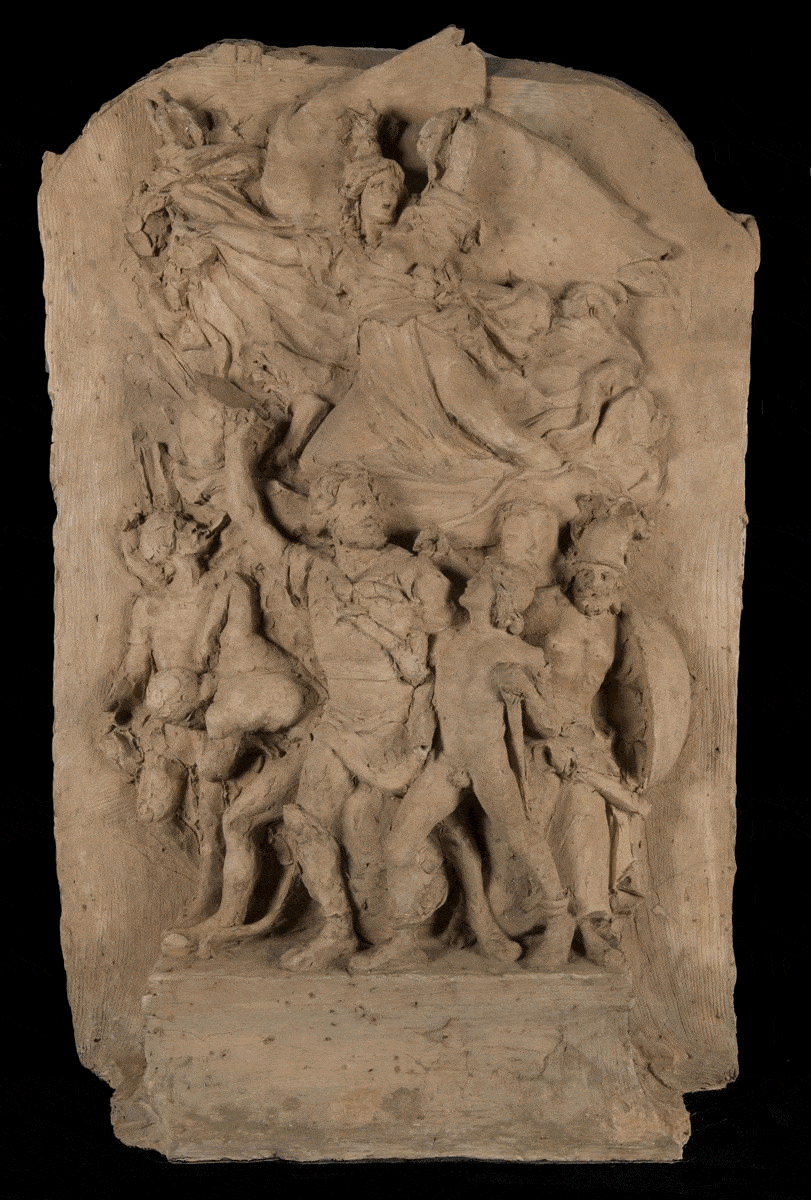
This work by French sculptor François Rude is a ceramic maquette, or scale model, of a sculptural decoration for the Arc de Triomphe, a commission awarded to Rude by the French government in 1833. The final sculpture, Départ des volontaires de 1792 (Departure of the Volunteers of 1792), also known as La Marseillaise, decorates the right pillar on the front of the Arc de Triomphe and is nearly 42 ½ feet tall. It depicts men in classical-style armor, led by a winged female warrior figure. This is a stylized rendering of a real historical event, the Battle of Valmy, where a French citizen army was victorious against Prussian and Austrian forces early in the Revolutionary Wars after the French Revolution.
This maquette is considerably smaller at only 27 ½ inches tall, but what it lacks in size it makes up for in sheer dynamism. The hand of the artist is visible in the roughly modeled surface and the abundant tool and finger marks. Though the figures are not carefully finished, they nevertheless seem alive, in fluid motion. The variegated colors and many inclusions and imperfections in the ceramic body hint to Rude using a lower quality clay which may never have meant to have been fired; sculptors often use clay to work out their thoughts before recycling it to craft the next iteration of their ideas. For whatever reason, however, this piece of sculpting was deemed important enough to be saved by firing it. The many cracks in the piece may have occurred during the firing process due to the impurities in the clay.

Above: detail of rightmost figure, showing toolmarks and fingerprints in the clay
Before conservation could begin on the sculpture, it had to be assessed to determine what prior treatment it had undergone. Thankfully, in this case, we have records of its treatment in 1984, as well as notes from former Brooklyn Museum conservator Jane Carpenter upon its acquisition by the Brooklyn Museum in 1989. Some time before 1984, both of the female figure’s hands had broken off and were lost, as were the proper right hands of two of the male figures. The work had suffered severe damage in the form of a horizontal break across the entire sculpture at the female figure’s waist, and was repaired (along with other cracks and breaks) with tinted plaster, which also covered the entire back surface. Finally, the entire front surface was coated with reddish-brown pigment. In 1984, the plaster and reddish-brown pigment was (mostly) removed, and the back was reinforced with four aluminum brackets adhered with epoxy and cotton tape. Losses along the horizontal break were filled in and inpainted with gouache.
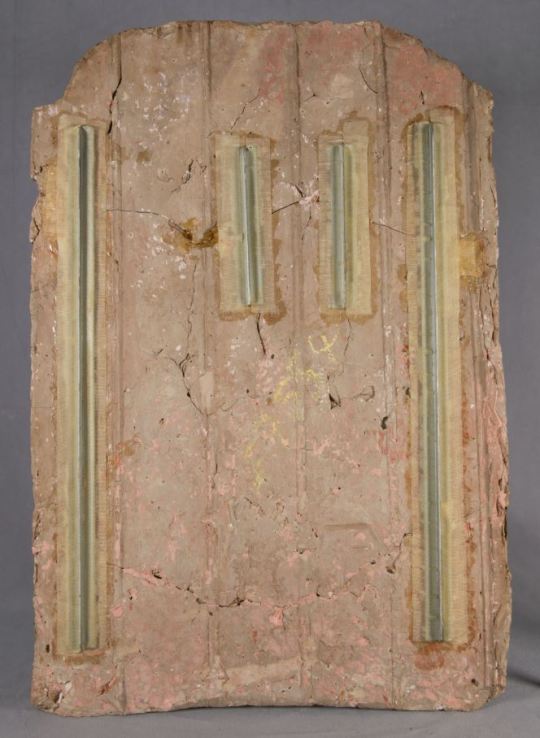
Above: the back side of the maquette before treatment
There were many spots of plaster and reddish-brown pigment that remained from the previous treatments, and there was also something oddly flat and one-dimensional about the color, too. Typically, a conservator will cover as little of the object’s surface as possible when inpainting fill material to match the surrounding area; in this case, it was found that almost the entire surface was coated with gouache! This may have been done to unify the repair work and create a more homogeneous appearance, as the gouache obscured the mottled coloring of the clay. However, this is an important feature in understanding the complicated history of this sculpture as well as its status as a “process object” created as part of a larger work. Though it is unclear what the “original” surface of the maquette may have looked like at the time of its creation, it was determined that removal of the gouache to reveal the current surface was preferable.

Above: removal of gouache with a swab, revealing ceramic surface underneath
Since gouache is soluble in water, cleaning the surface of the maquette was simple yet time-consuming. Small cotton swabs were hand-made, dampened, and carefully rolled across the surface. Along with the gouache, more of the old reddish-brown pigment was removed, though traces still remain in the many crevices. In total, wet cleaning the sculpture took over fifteen hours of work.

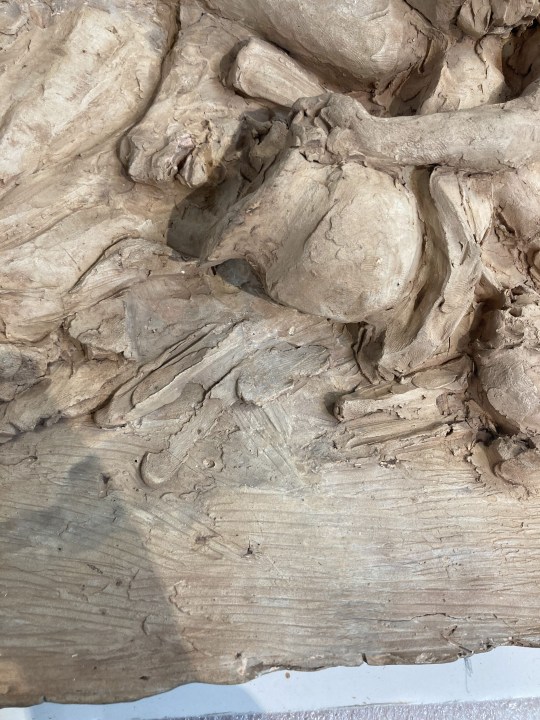
Above: before (left) and after (right) inpainting a filled crack
Instead of completely removing and redoing the old fills, which were made of a cellulose-based filler that appeared perfectly stable, they were shaped and resurfaced using an acrylic-based modern product to help them more effectively blend texturally into the surrounding area. Finally, since the color of the fills didn’t perfectly match the ceramic, they were aesthetically integrated with watercolor and gouache (applied only over the fills and not the entire surface!). These materials are easily soluble in water so the piece can be re-treated in the future if necessary. Now, instead of obscuring the complex and interesting surface of the maquette, it can be more fully appreciated as an object that gives unique and intimate insight into a great sculptor’s working processes.
Below: the maquette after treatment
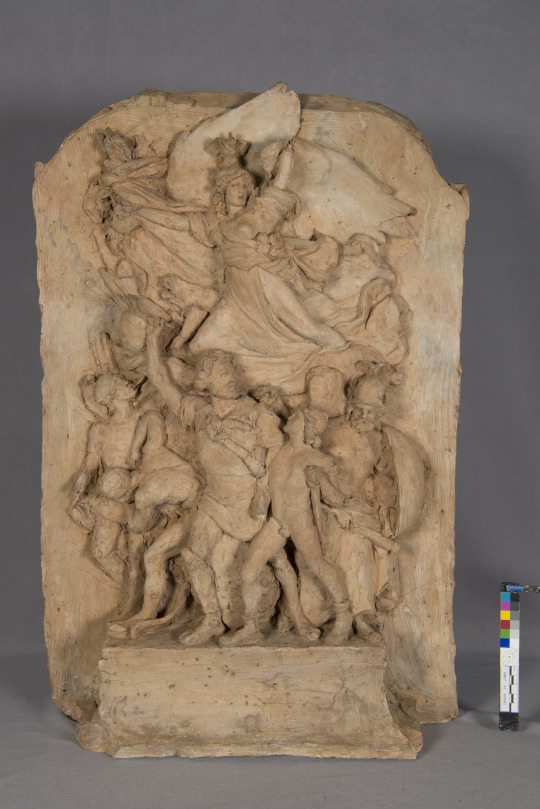
Written by Celeste Mahoney, Assistant Objects Conservator
#Brooklyn Museum#brooklyn#museum#art#conservation#art conservation#BkMConservation#sculpture#francoise rude#maquette#Arc de Triomphe
42 notes
·
View notes